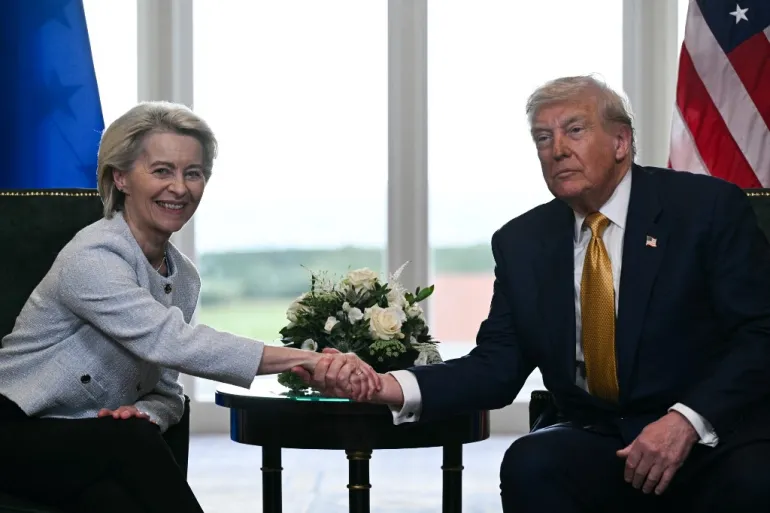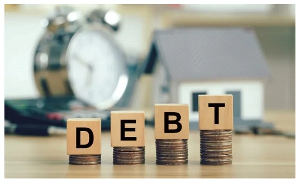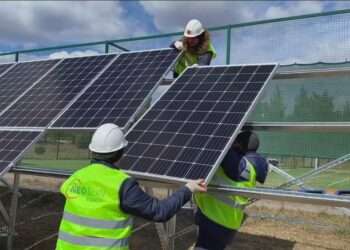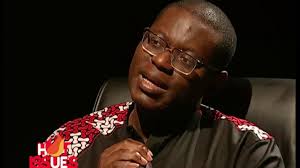The United States and the European Union (EU) have averted a full-blown transatlantic trade war days ahead of an August 1 deadline for the introduction of steep tariffs.
This came as they agreed to a trade framework. The deal, which imposes a 15 percent tariff on most European goods, came after a private meeting on Sunday between US President, Donald Trump and European Commission President, Ursula von der Leyen in Scotland.
Under the deal, the 15 percent tariff will be applied broadly to European exports, including automobiles. The 15 percent baseline rate marks a reprieve for Europe’s auto industry, which had since April been subject to a 25 percent duty on top of a pre-existing 2.5 percent levy.
Under the agreement, a limited range of goods, including plane parts, semiconductor equipment, certain chemicals and some agricultural products, will be fully exempt from tariffs.
Trump said that the EU also committed to buying about $750bn worth of US energy, in addition to boosting overall investment in the US by $600bn and placing a large order for military equipment.
The breakthrough follows months of tense back-and-forth exchanges between European officials and Trump, who has long accused the EU of unfair trade practices.
Earlier this month, negotiations appeared close to collapse when Trump threatened to proceed with the 30 percent tariff unless the EU matched the 15 percent rate he recently agreed to with Japan.
In anticipation of the possibility that the sides could fail to reach a deal, Brussels had prepared a long list of retaliatory tariffs targeting everything from beef and beer to Boeing aircraft and car parts.
However, the trade framework agreed between the US and EU days before Washington was due to impose a 30 percent tariff on EU imports, staves off — at least for now — far higher import duties on both sides that might have sent shock waves through economies around the globe.
If Trump eventually followed through on his threat of tariffs against Europe, meanwhile, it could have made everything from French cheese and Italian leather goods to German electronics and Spanish pharmaceuticals more expensive in the United States.
The deal is the most significant of Trump’s trade deals announced so far, following preliminary pacts with Japan, the United Kingdom, Indonesia, Vietnam and the Philippines, and a 90-day trade truce with China.
The EU is the US’ largest trading partner, with two-way trade in goods and services last year reaching nearly $2 trillion.
German Chancellor Friedrich Merz welcomed the agreement, saying that it has succeeded in averting a trade conflict “that would have hit the export-orientated German economy hard.”
“This applies in particular to the automotive industry, where the current tariffs of 27.5 percent will be almost halved to 15 percent.”
Friedrich Merz
Von der Leyen said the 15% tariffs were “across the board, all inclusive” and that “indeed, basically the European market is open.”
At a later news conference, she said that the $750 billion in additional US energy purchases was actually over the next three years — and would help ease the dependence on natural gas from Russia among the bloc’s countries.
Von der Leyen asserted that when the European Union and the United States work together as partners, the benefits are “tangible,” noting that the agreement “stabilized on a single, 15% tariff rate for the vast majority of EU exports” including cars, semiconductors and pharmaceuticals.
Von der Leyen also clarified that both sides agreed on “zero for zero tariffs on a number of strategic products,” like all aircraft and component parts, certain chemicals, certain generic drugs, semiconductor equipment, some agricultural products, natural resources and critical raw materials. “And we will keep working to add more products to this list,” she added.
Major Details Of US-EU Deal Pending
Meanwhile, some major details remain pending in the deal as many facets will require more work.
Von der Leyen stressed that the “framework means the figures we have just explained to the public, but, of course, details have to be sorted out.” She added, “And that will happen over the next weeks.”
Carsten Brzeski, Global Head of Macro for ING Research, said in a note, “The big caveat to today’s deal is that there is nothing on paper, yet.”
“The next hours and days will hopefully bring more clarity, Therefore, any assessment has to be taken with more than only one pinch of salt.”
Carsten Brzeski
There will be work to do on other fronts. Von der Leyen had a mandate to negotiate because the European Commission handles trade for member countries.
The Commission must now present the deal to member states and EU lawmakers, who will ultimately decide whether or not to approve it.
READ ALSO: NACOC Declares War on Illicit Drugs

















